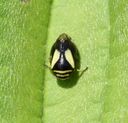Clastoptera
Clastoptera
Classification
- Phylum: Arthropoda
- Subphylum: Hexapoda
- Class: Insecta
- Order: Hemiptera
- Suborder: Auchenorrhyncha
- Infraorder: Cicadomorpha
- Superfamily: Cercopoidea
- Family: Clastopteridae
- Genus: Clastoptera
Pronunciation
How to pronounce Clastoptera: //klæˈstɒptərə//
These audio files are automatically generated. While they are not always 100% accurate, they are a good starting point.
Images






Summary
Clastoptera is a genus of spittlebugs in the family Clastopteridae, with at least 30 described species and many undescribed. They are characterized by their pale to dark coloration and inhabit areas primarily in the western United States and Canada, as well as other regions.
Physical Characteristics
Species are typically pale with many dark streaks or are almost entirely black. Males are usually dark while females are pale, but there are exceptions. Some species like Clastoptera hyperici are all-black, while others show distinct color variations.
Identification Tips
Identification often requires a view of the face. Dissection is often needed to separate species that are morphologically similar.
Habitat
Primarily found in coniferous habitats and associated with various woody and herbaceous plants.
Distribution
Confined to the western U.S., Canada, Texas, northern Mexico, and some parts of the eastern U.S. and Canada.
Diet
Many species are phloem-feeders, specializing on specific host plants, particularly woody plants and conifers.
Life Cycle
Life cycle details are not well-documented, but generally involve egg, nymph, and adult stages, with nymphs being the spittle-splashing stage.
Reproduction
Reproductive methods vary, but spittlebugs generally lay eggs on or near host plants. Mating rituals have not been extensively documented.
Predators
Common predators include birds and other insectivorous animals, though specific predation data is limited.
Ecosystem Role
Spittlebugs play a role in the ecosystem as herbivores, and their behavior can influence plant health and ecosystem dynamics.
Economic Impact
Some species can be agricultural pests, affecting the health of crops and ornamental plants due to their feeding habits.
Collecting Methods
- Netting adults from vegetation
- Trapping techniques with baited traps
- Light traps for nocturnal species
Preservation Methods
- Ethanol preservation for DNA studies
- Pinning specimens for traditional collection
- Mounted specimens for display
Evolution
The genus Clastoptera has undergone significant taxonomic revisions, and its species complexes reflect evolutionary diversity and adaptation to various environments.
Misconceptions
Some individuals confuse Clastoptera species with other spittlebug families due to similar morphological characteristics.
Tags
- spittlebugs
- Clastoptera
- insecta
- hemiptera
- eco-friendly
- entomology